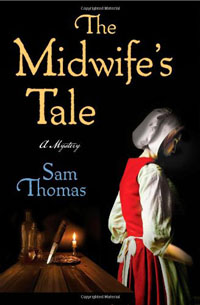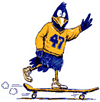A determined midwife and her knife-wielding servant set out to solve a murder mystery in Samuel Thomas’ first novel, The Midwife’s Tale, released in January. Thomas, a historian and former professor focused on Reformation England, weaves together fact and fiction to tell the story of Bridget Hodgson, the midwife and her servant Martha, both real women living in 17th century England. Thomas (Pomona College Class of 1991) takes his readers into Bridget’s world during the siege of York, not only creating an exciting mystery story but also revealing the complex political and religious issues of the era. The Midwife’s Tale has been met with positive reviews and is the first release in what is to become a four part series. Thomas now resides in Ohio and teaches high school history in addition to writing novels. He talks midwives, mystery, writing and more in the abridged and edited interview below.
 Your main character in the book, Bridget Hodgson, was a real midwife. What about this character, this profession, and this time period inspired you to write the book – and to make it into a murder mystery?
Your main character in the book, Bridget Hodgson, was a real midwife. What about this character, this profession, and this time period inspired you to write the book – and to make it into a murder mystery?
When I was contemplating the jump from college-level teaching, the one thing that gave me pause was that I would have to give up my research. I loved writing about midwives and didn’t want to stop. I’d been half in love with Bridget ever since I found her in the archives, so she was a natural fit for the issues of social class, gender, and crime that I wanted to explore in my books.
It seemed natural for me to write a mystery for a few reasons. First, I never had to worry about where to start and end the book! You begin with a body and end with a hanging. Second, and more importantly, midwives are natural sleuths. They know the community’s secrets, and are in the habit of enforcing law and order.
When I was putting together the story, the siege of York during the English Civil War seemed like too good an opportunity to pass up. And since the Civil War involved Parliament’s rebellion against the king, I decided to write about treasons big and small. In The Midwife’s Tale, a wife is suspected of murdering her husband (a crime known as petty treason), while outside the city, Parliament has risen up against the king.
How much of the book contains pieces of the real life character, and how much comes from you?
It’s a mix of fact and fiction. The historical and literary Bridgets were both wealthy midwives who practiced in York in the 17th century, and I did my best to capture her strength of personality. (This is a woman who named her own daughter and four goddaughters after herself.) Both had assistants named Martha, and were married to Phineas Hodgson. The historical Phineas was every bit the spendthrift as his literary counterpart.
For the sake of the narrative, I made the literary Bridget childless, and filled in a lot of details that are unknown and unknowable. The more I write, the more fiction I’ll have to include, but I’ll continue to do my best to stay true to the larger historical issues.
This is your first book. What was the process like?
When it comes to writing, I’m a lot like an infant: so long as I’m on a schedule, I’m in good shape. I get up at around 4:45 every morning and then write until it is time to go to work. I might do some other writing in the evening – book reviews for the Plain Dealer or blog posts, but by then I’m usually too tired to be very creative.
The hardest part of writing is the rewriting. Writing a first draft is like dumping out a box of puzzle pieces. The hard part is trying to get them all to fit together and make sense. Inevitably there are plot lines or characters that need to be cut, or scenes that need to be moved, and once you move one piece, others also have to go. It can be pretty stressful!
What’s next for you?
The Harlot’s Tale, the second book in the series, is due out in January 2014, and I’ve just finished a first draft of the third book, tentatively titled, The Witch-Hunter’s Tale. Happily, Minotaur-St. Martin’s also bought a fourth book in the series. In the longer term, I’m hoping to find time to write a more ambitious book about witchcraft in the American colonies. But that’s as far as I’ve gotten!


